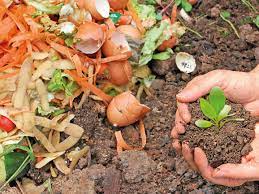Courtesy : en.wikipedia.org
Composting
Compost is a mixture of ingredients used as plant fertilizer and to improve soil’s physical, chemical and biological properties. It is commonly prepared by decomposing plant, food waste, recycling organic materials and manure. The resulting mixture is rich in plant nutrients and beneficial organisms, such as bacteria, protozoa, nematodes and fungi. Compost improves soil fertility in gardens, landscaping, horticulture, urban agriculture, and organic farming, reducing dependency on commercial chemical fertilizers. The benefits of compost include providing nutrients to crops as fertilizer, acting as a soil conditioner, increasing the humus or humic acid contents of the soil, and introducing beneficial microbes that help to suppress pathogens in the soil and reduce soil-borne diseases.
At the simplest level, composting requires gathering a mix of ‘greens’ (green waste) and ‘browns’ (brown waste). Greens are materials rich in nitrogen such as leaves, grass, and food scraps. Browns are woody materials rich in carbon, such as stalks, paper, and wood chips.The materials break down into humus in a process taking months. Composting can be a multi-step, closely monitored process with measured inputs of water, air, and carbon- and nitrogen-rich materials. The decomposition process is aided by shredding the plant matter, adding water, and ensuring proper aeration by regularly turning the mixture in a process using open piles or “windrows.”Fungi, earthworms, and other detritivores further break up the organic material. Aerobic bacteria and fungi manage the chemical process by converting the inputs into heat, carbon dioxide, and ammonium.
Composting is an important part of waste management, since food and other compostable materials make up about 20% of waste in landfills, and these materials take longer to biodegrade in the landfill.Composting offers an environmentally superior alternative to using organic material for landfill because composting reduces anaerobic methane emissions, and provides economic and environmental co-benefits. For example, compost can also be used for land and stream reclamation, wetland construction, and landfill cover.
Fundamentals
Home compost barrel
Compost bins at the Evergreen State College Organic Farm in Washington State
Materials in a compost pile
Food scraps compost heap
Composting is an aerobic method of decomposing organic solid wastes. It can therefore be used to recycle organic material. The process involves decomposing organic material into a humus-like material, known as compost, which is a good fertilizer for plants.
Composting organisms require four equally important ingredients to work effectively:
- Carbon is needed for energy; the microbial oxidation of carbon produces the heat required for other parts of the composting process.High carbon materials tend to be brown and dry.
- Nitrogen is needed to grow and reproduce more organisms to oxidize the carbon.High nitrogen materials tend to be green[1] and wet.They can also include colourful fruits and vegetables.
- Oxygen is required for oxidizing the carbon, the decomposition process.Aerobic bacteria need oxygen levels above 5% to perform the processes needed for composting.
- Water is necessary in the right amounts to maintain activity without causing anaerobic conditions.
Certain ratios of these materials will allow microorganisms to work at a rate that will heat up the compost pile. Active management of the pile (e.g., turning over the compost heap with a pitchfork) is needed to maintain sufficient oxygen and the right moisture level. The air/water balance is critical to maintaining high temperatures 130–160 °F (54–71 °C) until the materials are broken down.
Composting is most efficient with a carbon-to-nitrogen ratio of about 25:1.[ Hot composting focuses on retaining heat to increase the decomposition rate thus producing compost more quickly. Rapid composting is favored by having a carbon-to-nitrogen ratio of ~30 carbon units or less. Above 30, the substrate is nitrogen starved. Below 15, it is likely to outgas a portion of nitrogen as ammonia.
Nearly all dead plant and animal materials have both carbon and nitrogen in different amounts.Fresh grass clippings have an average ratio of about 15:1 and dry autumn leaves about 50:1 depending upon species.Composting is an ongoing and dynamic process, adding new sources of carbon and nitrogen consistently as well as active management is important.
Organisms
Organisms can break down organic matter in compost if provided with the correct mixture of water, oxygen, carbon, and nitrogen.They fall into two broad categories: chemical decomposers which perform chemical processes on the organic waste, and physical decomposers which process the waste into smaller pieces through methods such as grinding, tearing, chewing, and digesting.





